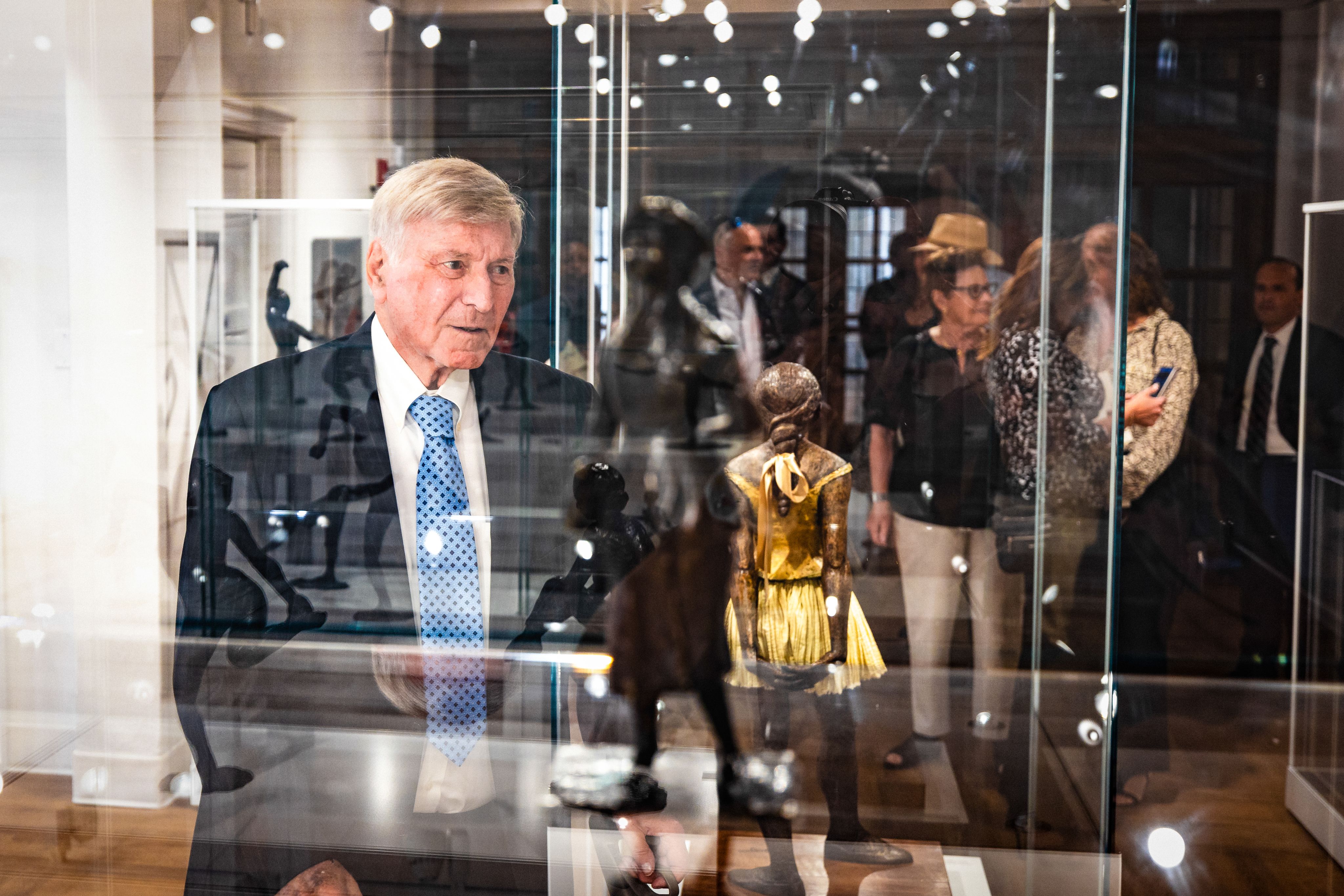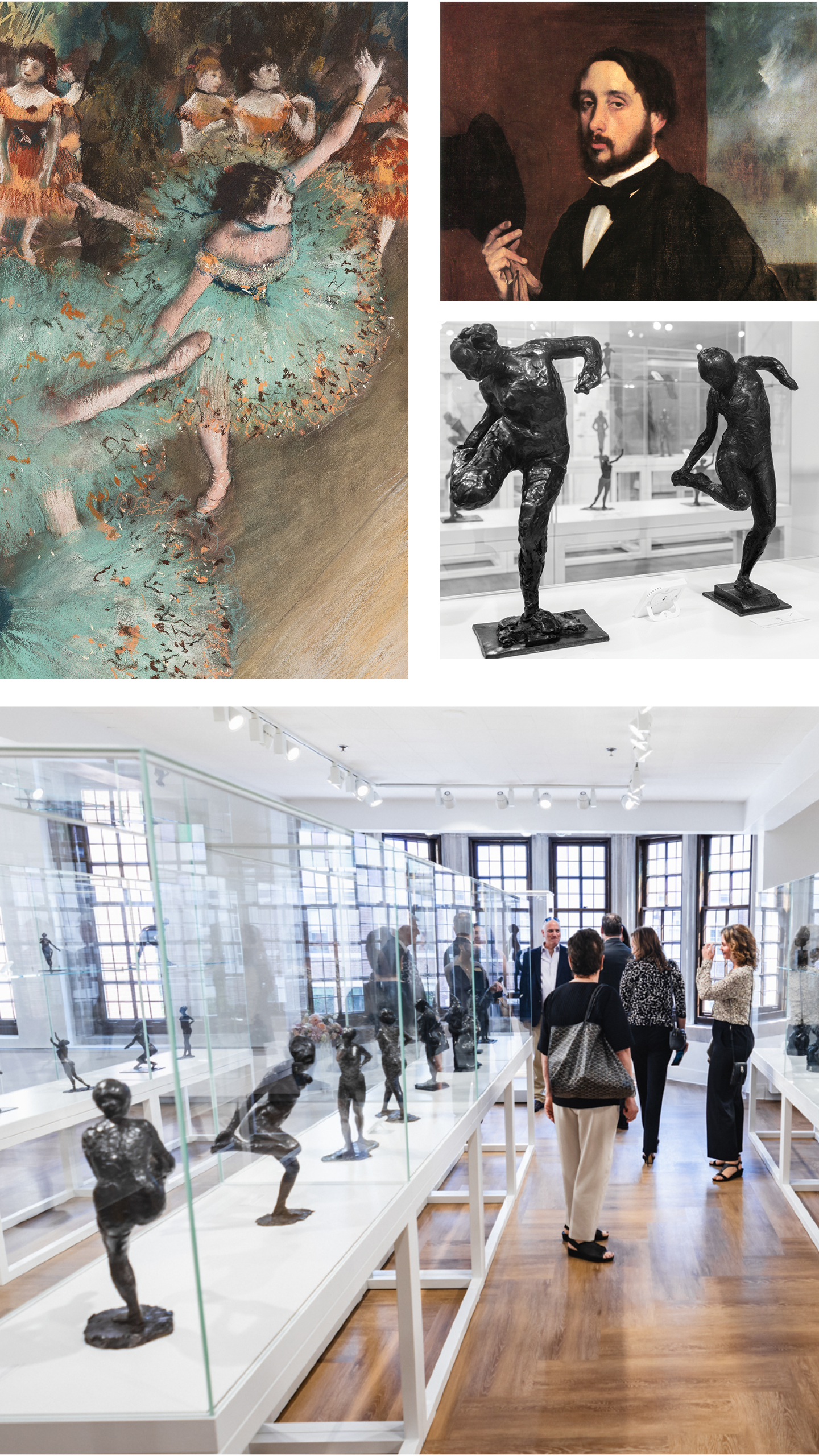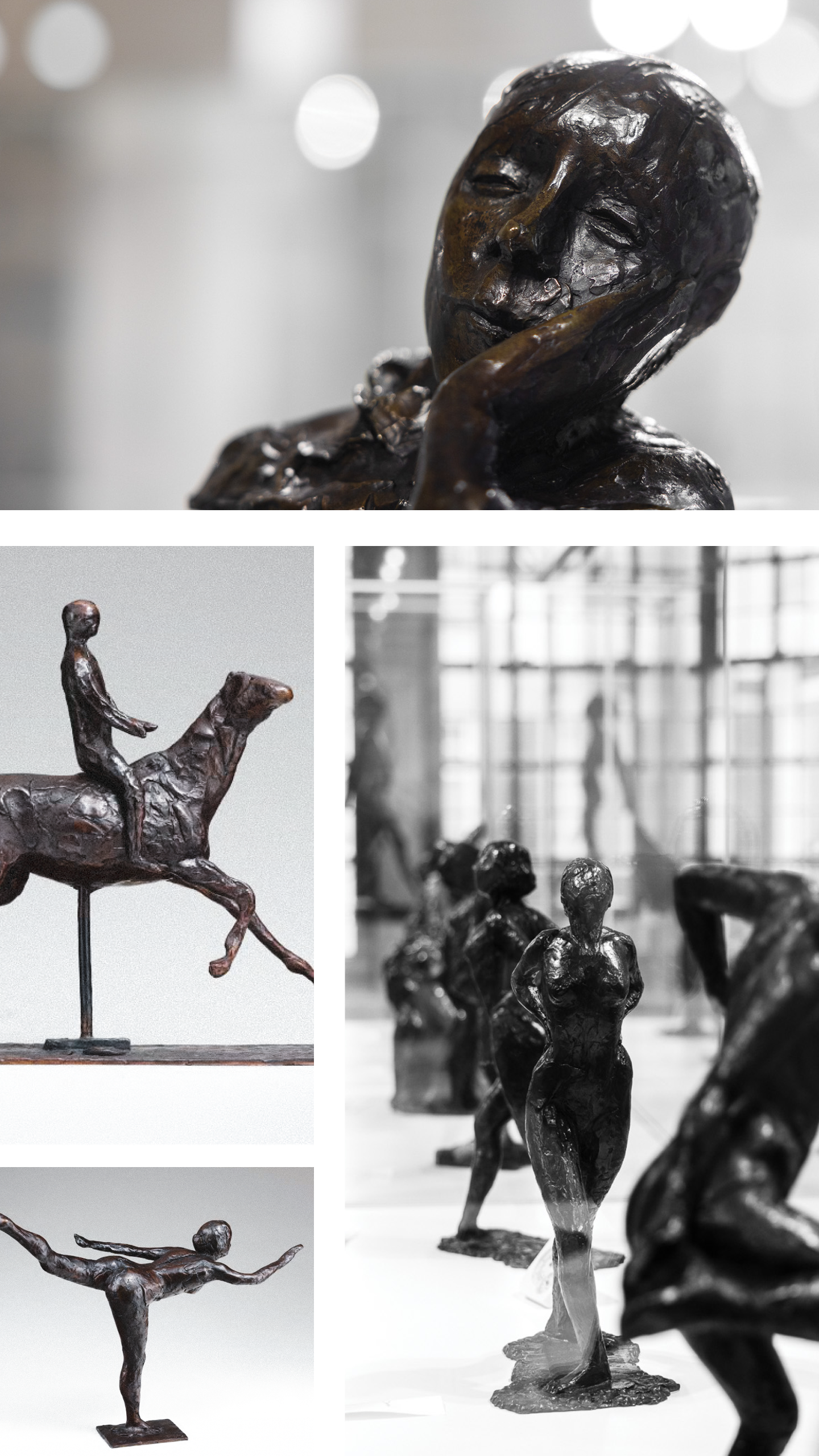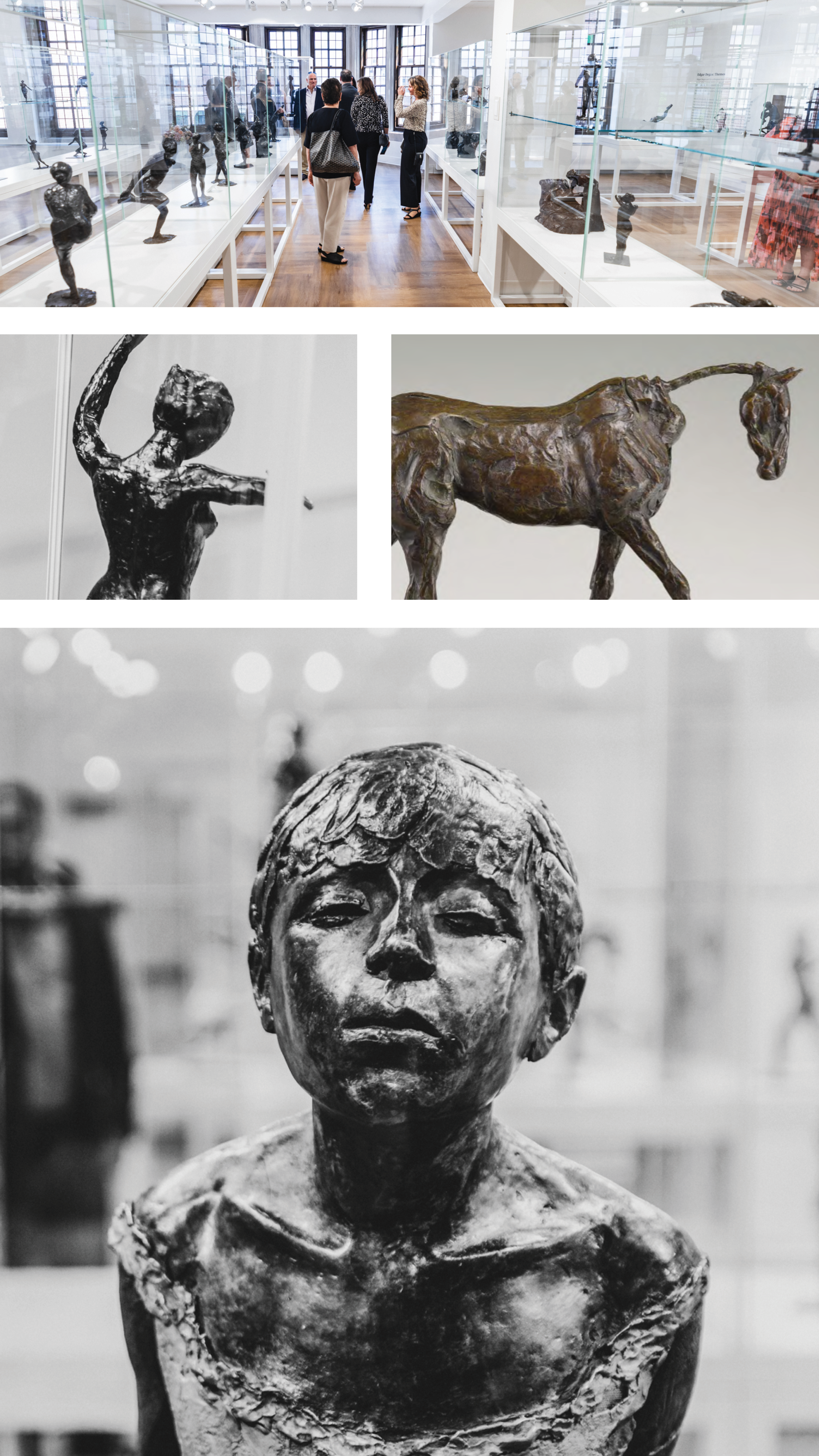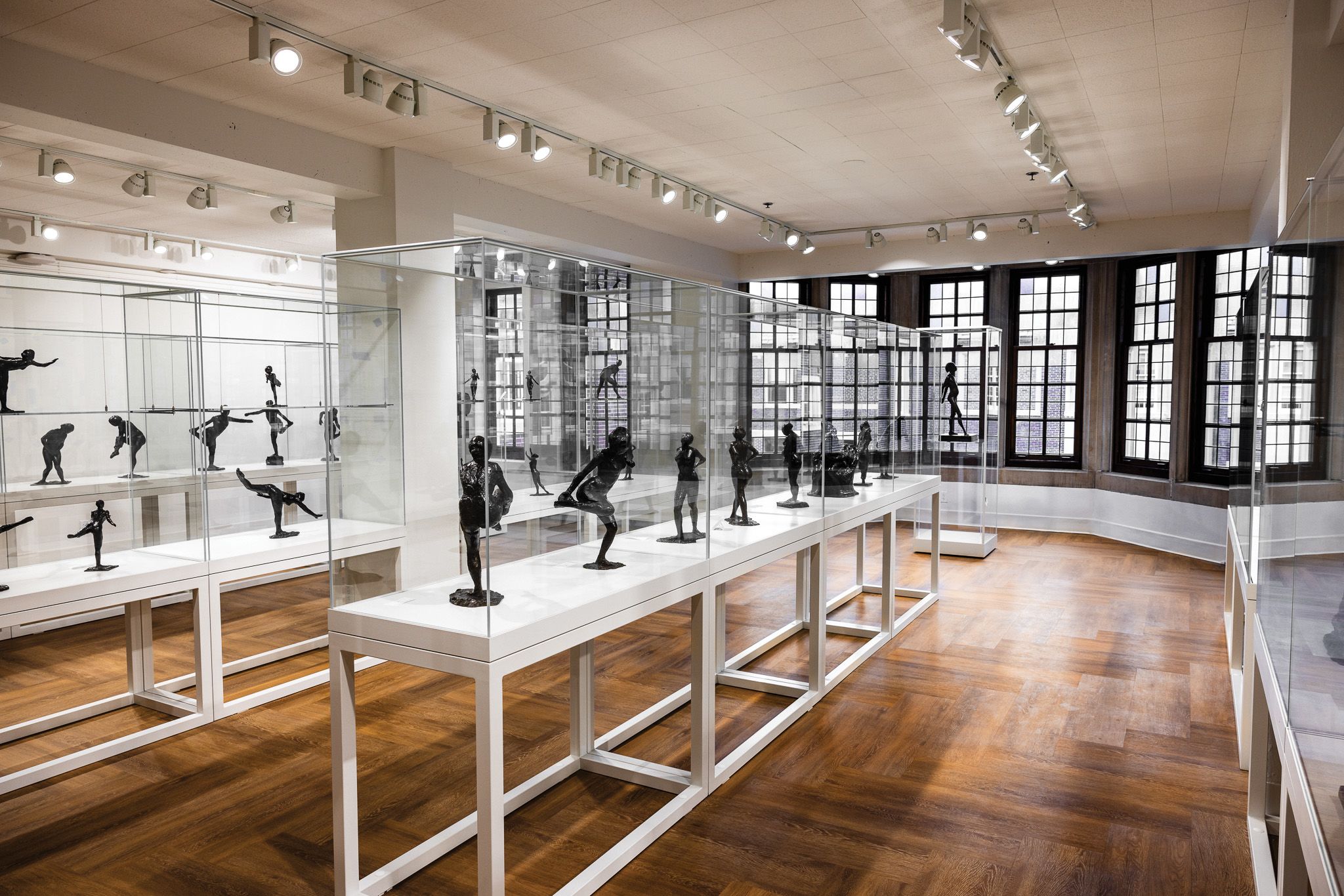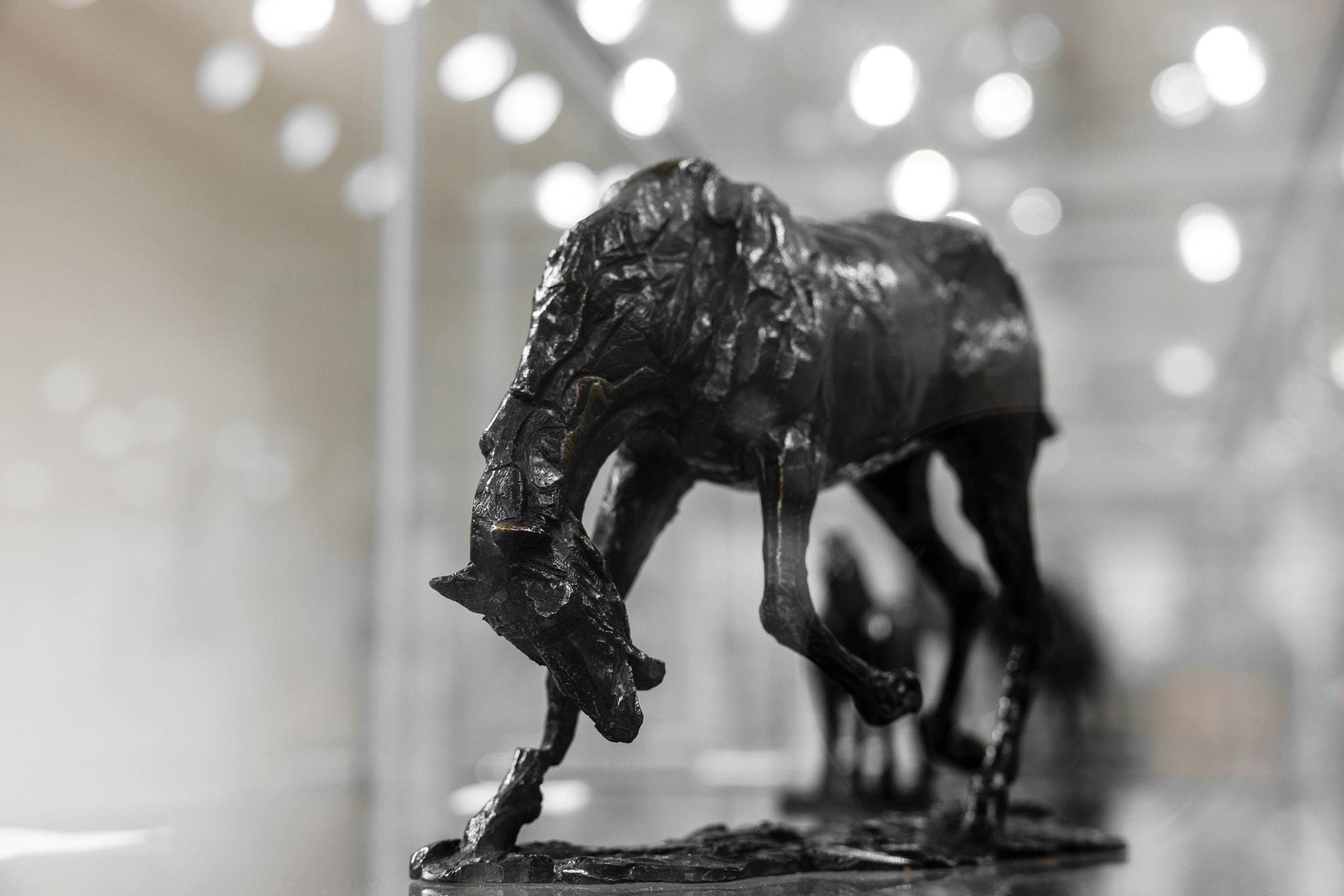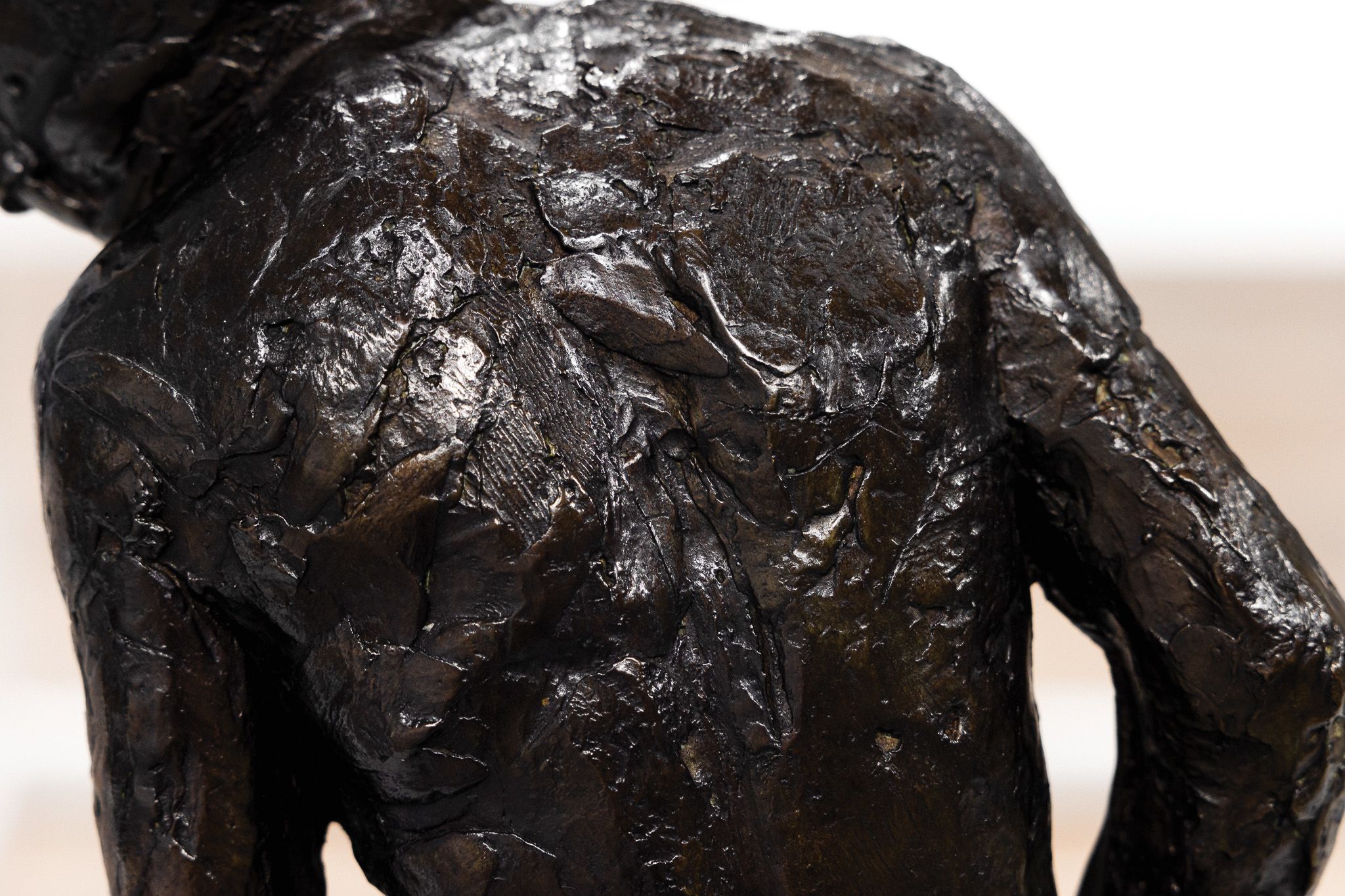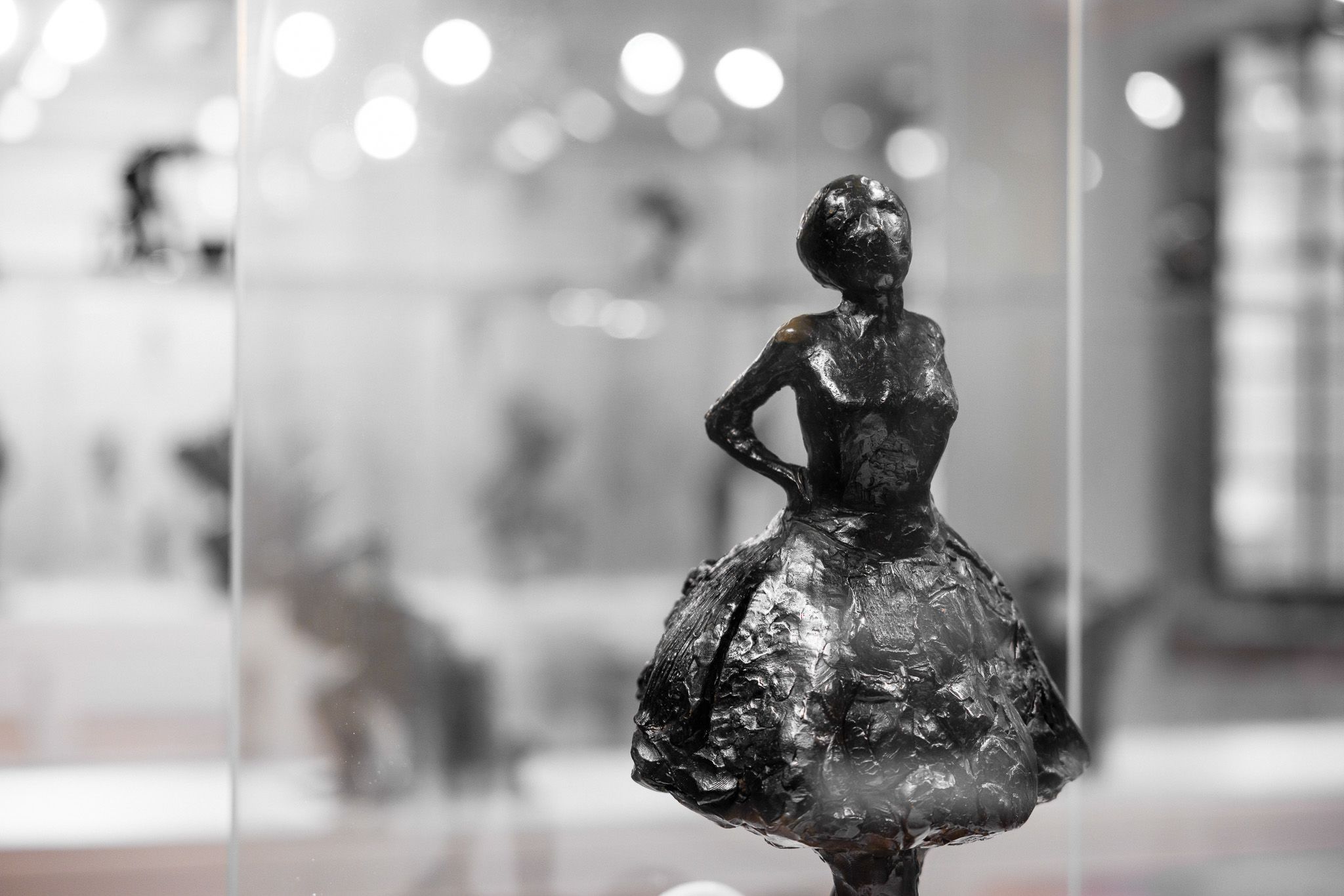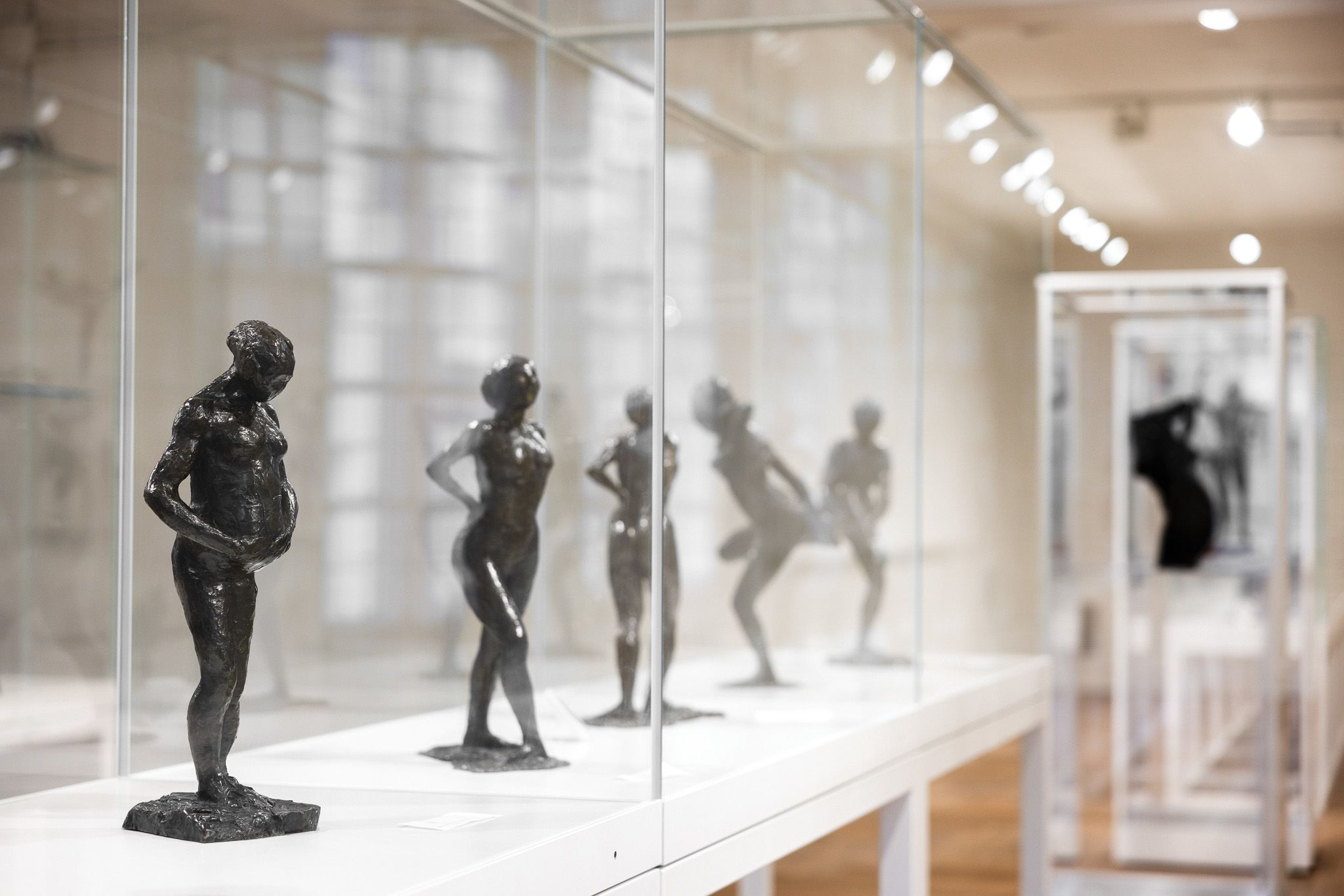
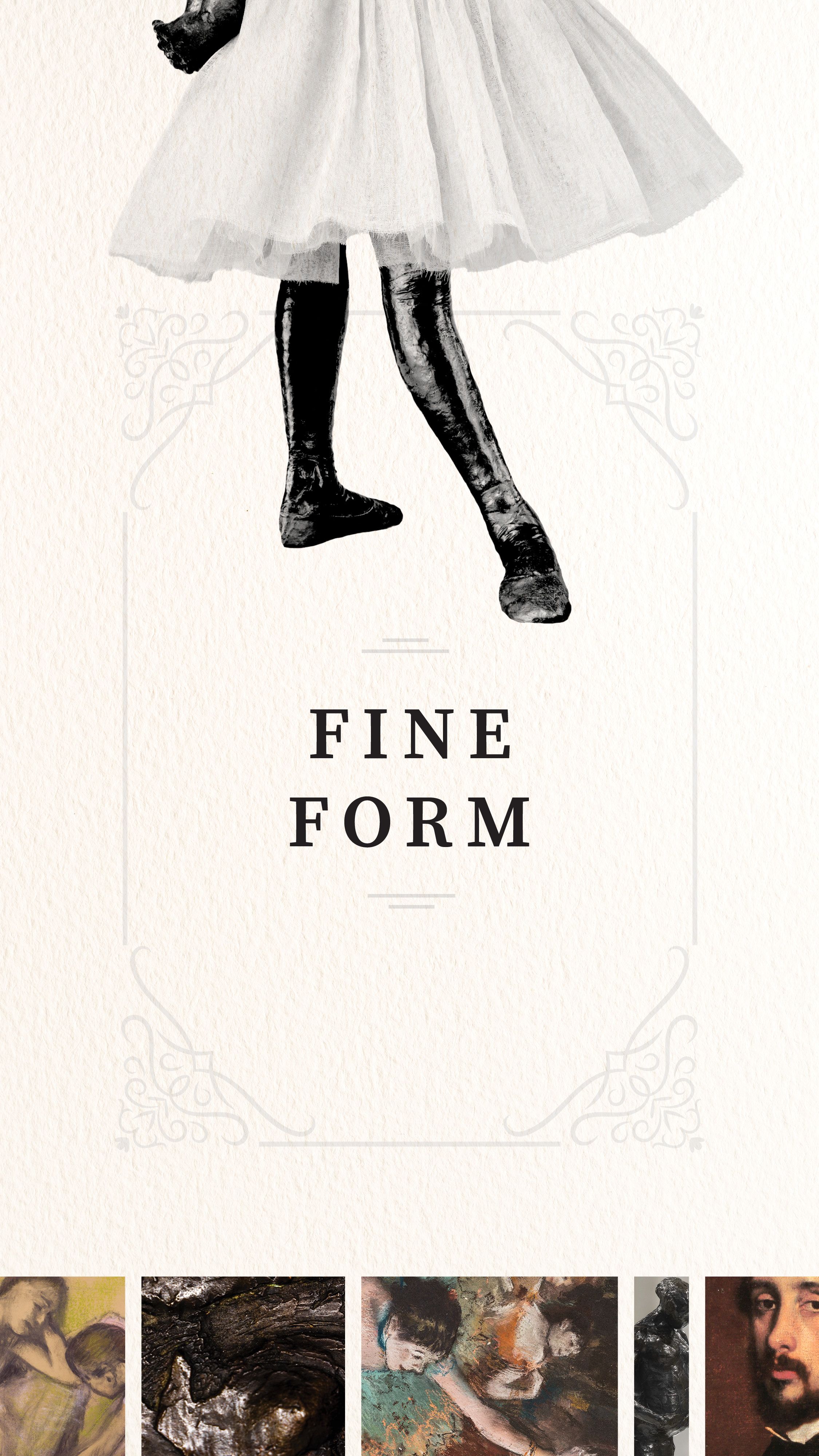
// By Nicolle Kain (LA’22, M’22, PG’24)
Picture yourself strolling along the boulevards of Paris in the spring of 1881, en route to the sixth impressionist exhibition, a significant art show primarily organized by Edgar Degas. Upon arrival, a dazzling array of oil paintings appears before you—works by Mary Cassatt, Paul Gauguin, and Camille Pissarro among them.
The atmosphere is charged with the spirit of artistic revolution as visitors admire the broad interpretation of impressionism depicted in scenes of modern, urban, and everyday life.
As you pass into an adjoining room, a surprise awaits: a wax sculpture of a young ballerina stands on display, complete with real hair, fabric attire, and dainty ballet slippers. Murmurs ripple through the crowd; disapproval is palpable. The girl’s expression and pose appear unremarkable to many, the choice of materials is unconventional, and the portrayal of a young dancer in such a frank, unidealized form is deemed provocative, even brutish.
This is Degas’s La Petite Danseuse de Quatorze Ans (Little Dancer, Aged Fourteen). Though greeted with criticism and controversy at its debut, it will become one of the most beloved pieces of art in the world.
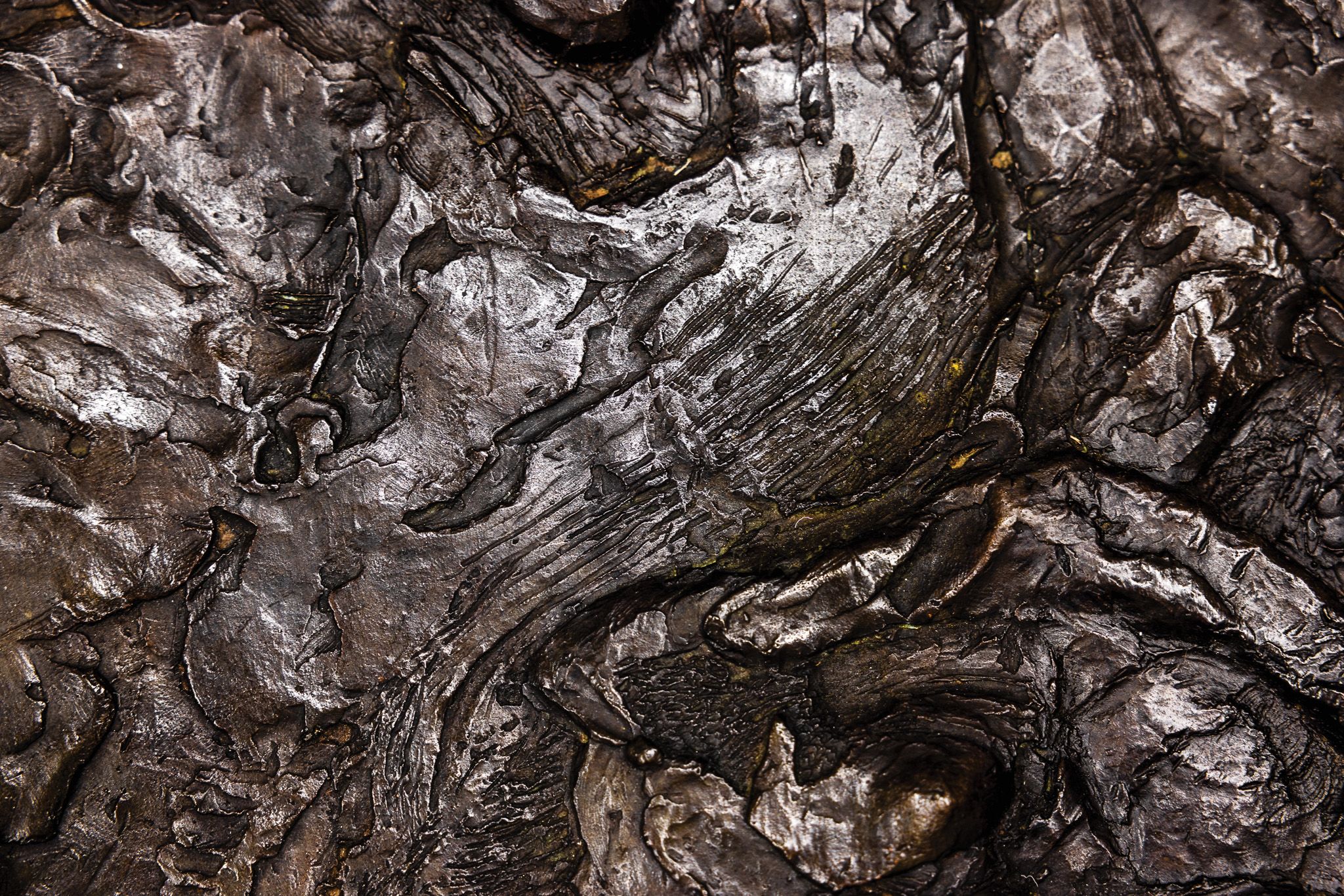
// By Nicolle Kain (LA’22, M’22, PG’24)
Picture yourself strolling along the boulevards of Paris in the spring of 1881, en route to the sixth impressionist exhibition, a significant art show primarily organized by Edgar Degas. Upon arrival, a dazzling array of oil paintings appears before you—works by Mary Cassatt, Paul Gauguin, and Camille Pissarro among them.
The atmosphere is charged with the spirit of artistic revolution as visitors admire the broad interpretation of impressionism depicted in scenes of modern, urban, and everyday life.
As you pass into an adjoining room, a surprise awaits: a wax sculpture of a young ballerina stands on display, complete with real hair, fabric attire, and dainty ballet slippers. Murmurs ripple through the crowd; disapproval is palpable. The girl’s expression and pose appear unremarkable to many, the choice of materials is unconventional, and the portrayal of a young dancer in such a frank, unidealized form is deemed provocative, even brutish.
This is Degas’s La Petite Danseuse de Quatorze Ans (Little Dancer, Aged Fourteen). Though greeted with criticism and controversy at its debut, it will become one of the most beloved pieces of art in the world.

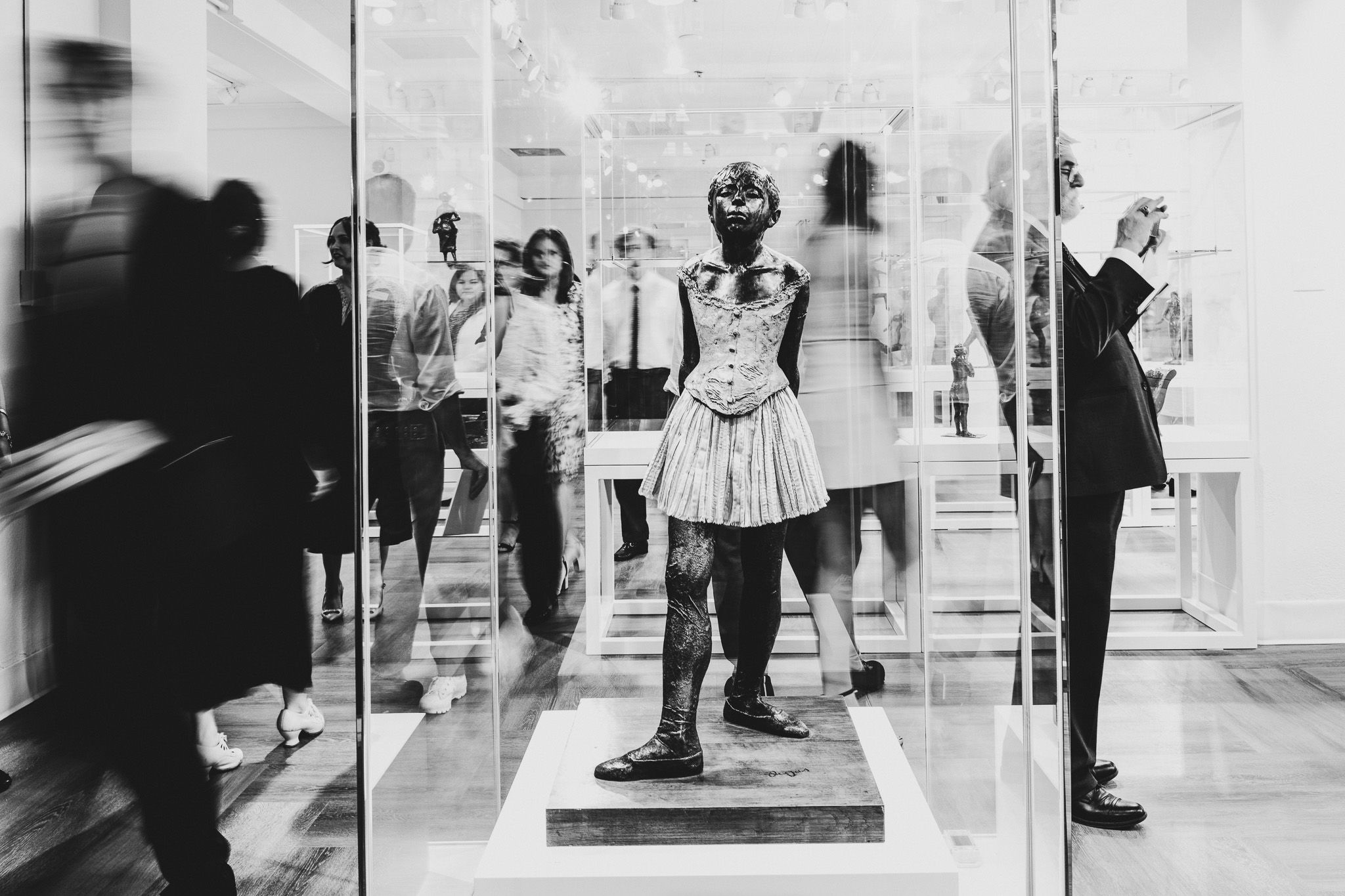
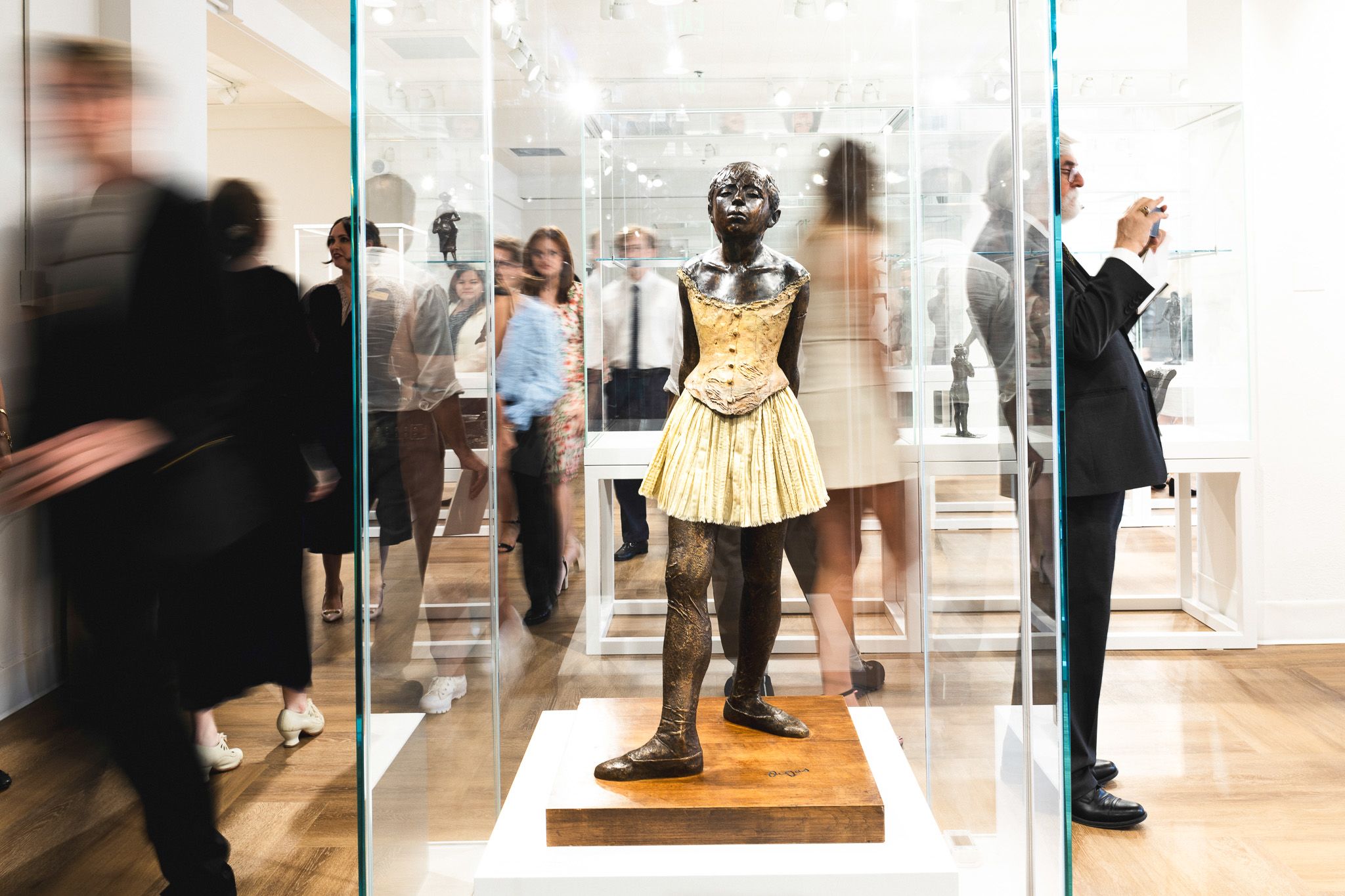
“
Art is not what you
see but what you
make others see.
—Edgar Degas
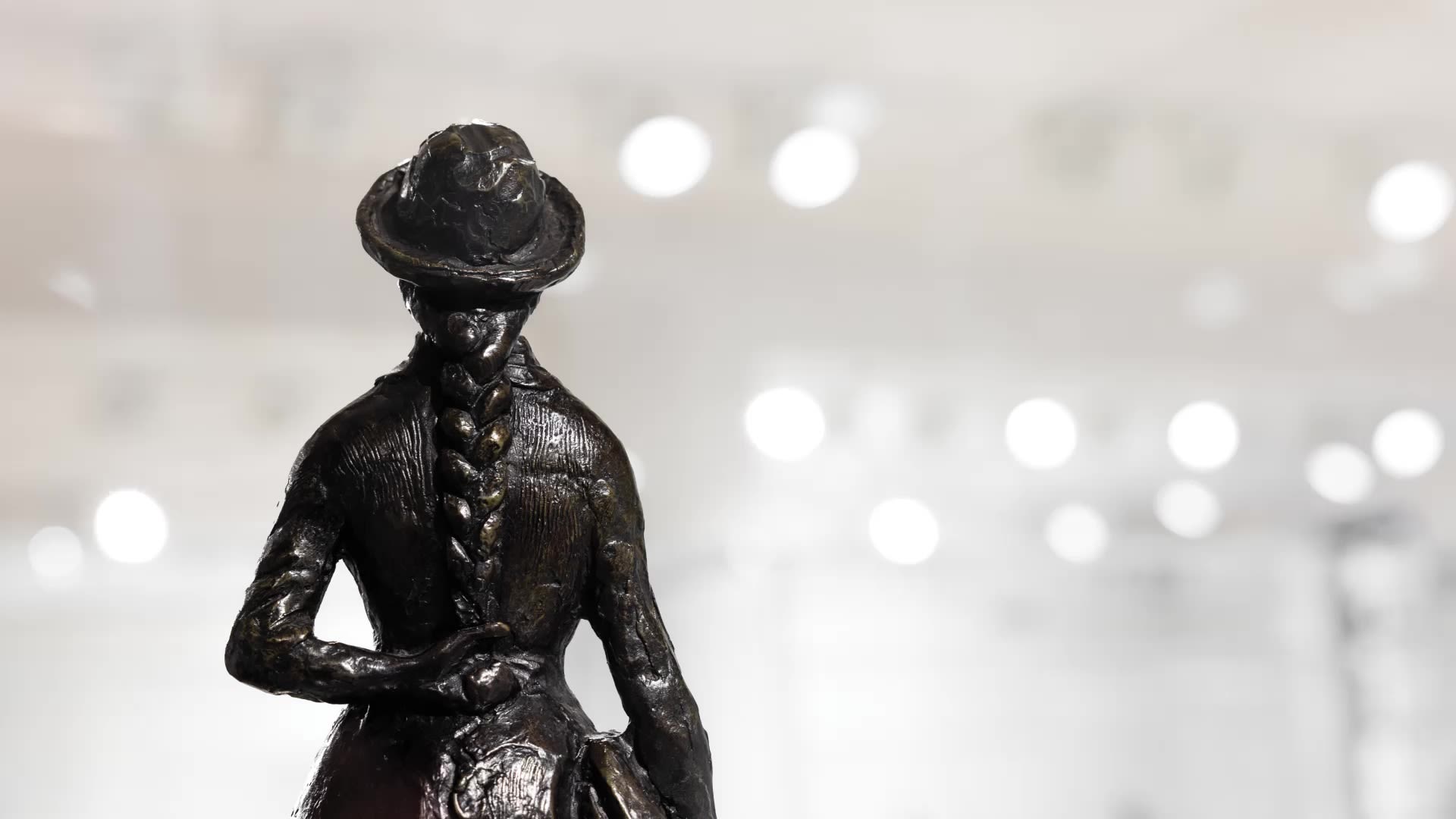
“
Art is not what you see but what you make others see.
—Edgar Degas

Although Degas is best known for his paintings, his artistic output extended beyond the canvas. As his eyesight began to fail—Degas first noticed weakness in his vision at age 19, and by 36, he was nearly blind in one eye—he increasingly turned to sculpture to aid his creative process.
Working privately in his studio, he crafted around 150 small figures of dancers, bathers, and horses using a variety of materials, including clay, wax, wire, and wood. These sculptural works were intended as private explorations rather than public displays, resulting in many unfinished pieces.
During his lifetime, Degas exhibited only one sculpture: Little Dancer, which depicts Marie van Goethem, a ballet student who attended the Paris Opera dance school. After it was criticized at the 1881 exhibition, the piece was not seen again publicly until after Degas’s death in 1917, when his heirs commissioned bronze castings of 74 of his sculptures.
There are only two known complete sets of Degas’s bronzes, and one of them found its way to Boilermaker Avrum “Av” Gray (ME’56).
After obtaining his degree in mechanical engineering, Gray spent several decades in automotive manufacturing.
“When I was 45, I had a midlife crisis and wanted a career change,” he says. “The epicenter of the Options Exchange was in Chicago, and I went there to do something different. Thanks to Purdue, I understood options and the math behind them. I had a particular brand of trading that was mine. In the end, I hired about 150 people, and we had operations on every exchange in the United States. That’s what I did for a living for the next 25 years.”
Av Gray and Little Dancer
Throughout his career, Gray served in executive positions for Alloy Consolidated Industries, an automotive aftermarket company; Lynch Systems in Georgia, a glass press supplier to the television and computer industry; Material Sciences Corporation in Illinois; Nashua Corporation, a paper products company in New Hampshire; Lynch Corporation, a holding company in New York; and SL Industries of New Jersey, specializing in power and motion controls for medical, aerospace, and other industries.
In 2019, Purdue’s School of Mechanical Engineering honored Gray with an Outstanding Mechanical Engineer Award in recognition of his outstanding character, leadership, and commitment to excellence.

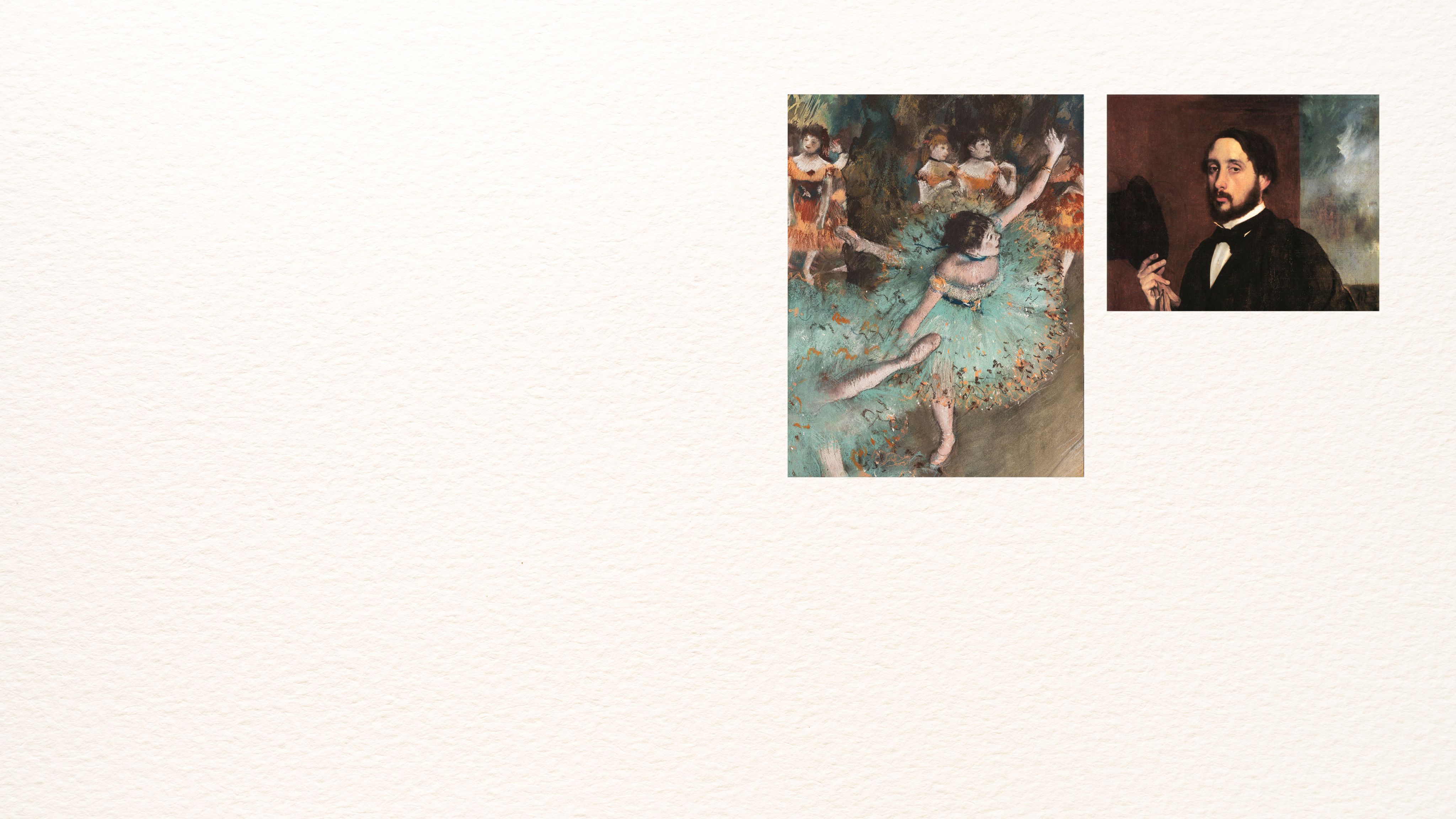

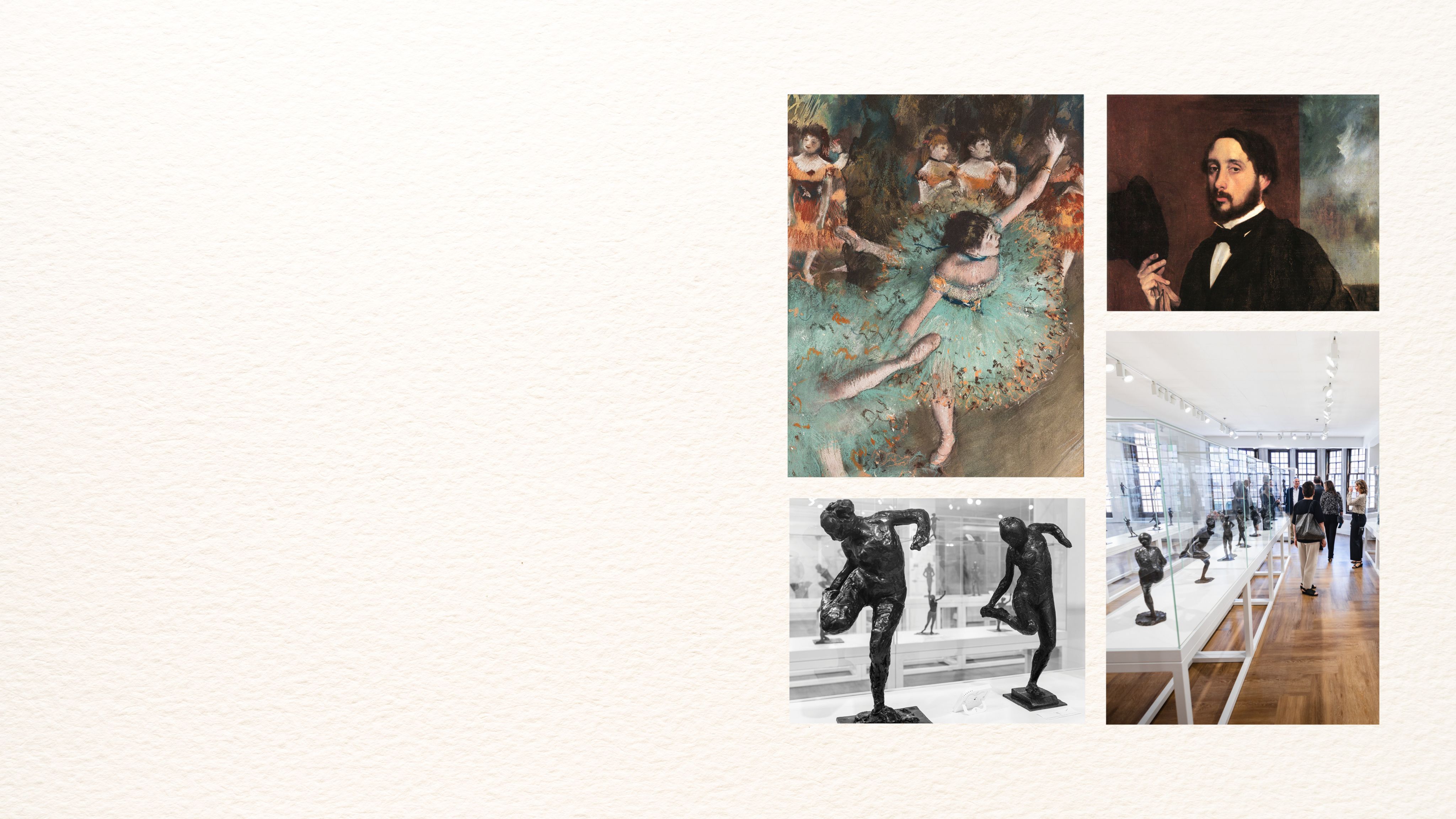
Although Degas is best known for his paintings, his artistic output extended beyond the canvas. As his eyesight began to fail—Degas first noticed weakness in his vision at age 19, and by 36, he was nearly blind in one eye—he increasingly turned to sculpture to aid his creative process.
Working privately in his studio, he crafted around 150 small figures of dancers, bathers, and horses using a variety of materials, including clay, wax, wire, and wood. These sculptural works were intended as private explorations rather than public displays, resulting in many unfinished pieces.
During his lifetime, Degas exhibited only one sculpture: Little Dancer, which depicts Marie van Goethem, a ballet student who attended the Paris Opera dance school. After it was criticized at the 1881 exhibition, the piece was not seen again publicly until after Degas’s death in 1917, when his heirs commissioned bronze castings of 74 of his sculptures.
There are only two known complete sets of Degas’s bronzes, and one of them found its way to Boilermaker Avrum “Av” Gray (ME’56).
After obtaining his degree in mechanical engineering, Gray spent several decades in automotive manufacturing.
“When I was 45, I had a midlife crisis and wanted a career change,” he says. “The epicenter of the Options Exchange was in Chicago, and I went there to do something different. Thanks to Purdue, I understood options and the math behind them. I had a particular brand of trading that was mine. In the end, I hired about 150 people, and we had operations on every exchange in the United States. That’s what I did for a living for the next 25 years.”
Av Gray and Little Dancer
Throughout his career, Gray served in executive positions for Alloy Consolidated Industries, an automotive aftermarket company; Lynch Systems in Georgia, a glass press supplier to the television and computer industry; Material Sciences Corporation in Illinois; Nashua Corporation, a paper products company in New Hampshire; Lynch Corporation, a holding company in New York; and SL Industries of New Jersey, specializing in power and motion controls for medical, aerospace, and other industries.
In 2019, Purdue’s School of Mechanical Engineering honored Gray with an Outstanding Mechanical Engineer Award in recognition of his outstanding character, leadership, and commitment to excellence.

“
You must aim high, not in what you are going to do at some future date, but in what you are going to make yourself do today. Otherwise, working is just a waste of time.
—Edgar Degas

“
You must aim high, not in what you are going to do at some future date, but in what you are going to make yourself do today. Otherwise, working is just a waste of time.
—Edgar Degas

Gray’s pursuits extend beyond his professional career. Passionate about art, he began building his collection soon after leaving the university, acquiring works from artists he admired, including an oil painting by Pablo Picasso.
A chance encounter with a man who owned a broken set of Degas’s bronze sculptures marked the beginning of an unexpected journey for Gray.
“I thought they were very nice, so I bought a few,” he says. Over the following years, he maintained contact with the collector, who eventually approached him with a rare offer—a complete set. “I didn’t quite know what I would do with them, but I thought they would be a wonderful thing to own.”
Among the pieces was Little Dancer, which graced Gray’s living room for two decades while most of the other sculptures remained in storage. A desire to share these masterpieces with others led him to donate the entire collection to his alma mater.
“We were created to look at one another, weren’t we?”—Edgar Degas
“The Degas collection is so different from the engineering and technical fields, which is what Purdue is known for,” Gray says. “I feel this will give Purdue students and visitors a much broader view of the world and of art.”



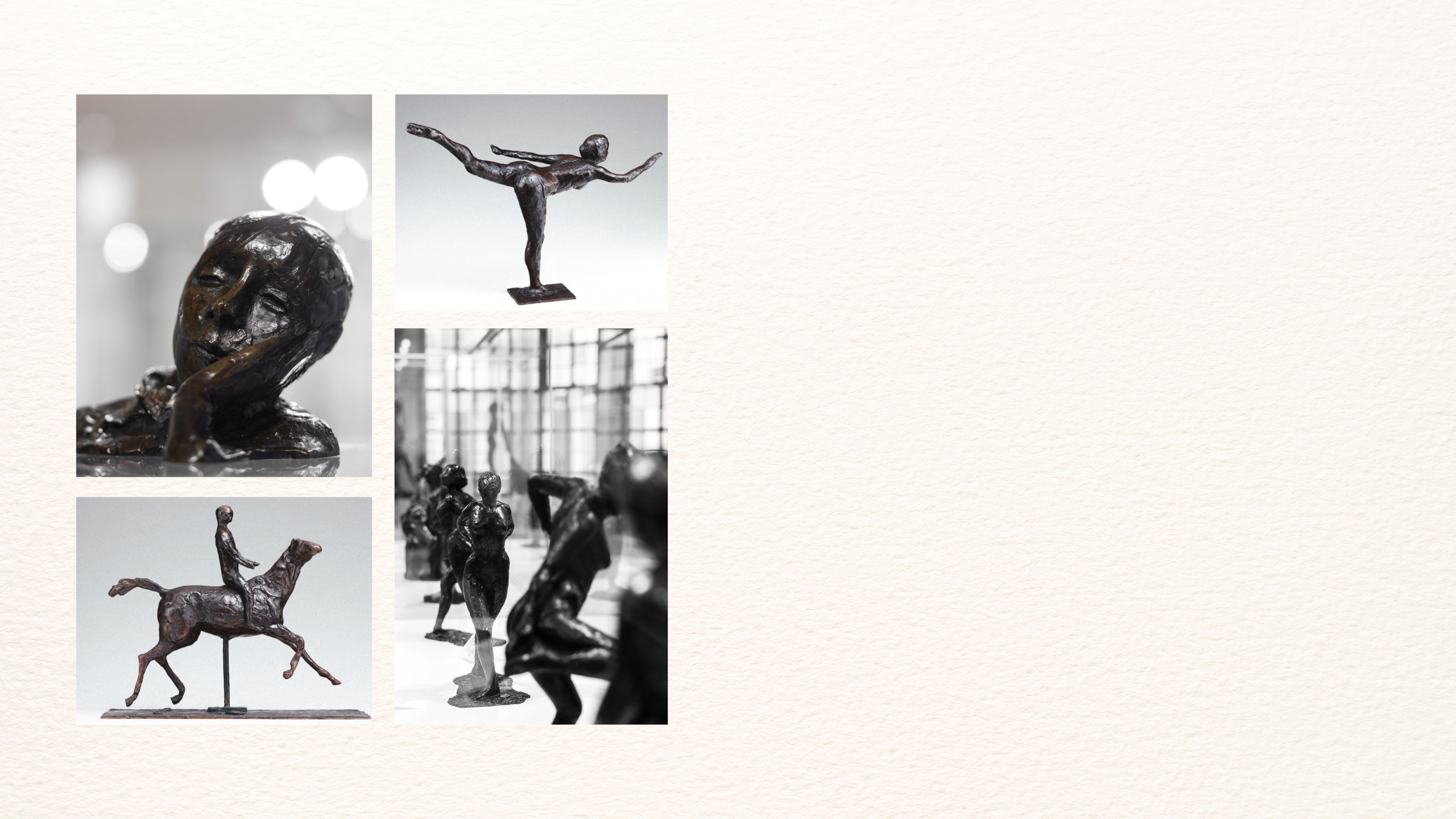
Gray’s pursuits extend beyond his professional career. Passionate about art, he began building his collection soon after leaving the university, acquiring works from artists he admired, including an oil painting by Pablo Picasso.
A chance encounter with a man who owned a broken set of Degas’s bronze sculptures marked the beginning of an unexpected journey for Gray.
“I thought they were very nice, so I bought a few,” he says. Over the following years, he maintained contact with the collector, who eventually approached him with a rare offer—a complete set. “I didn’t quite know what I would do with them, but I thought they would be a wonderful thing to own.”
Among the pieces was Little Dancer, which graced Gray’s living room for two decades while most of the other sculptures remained in storage. A desire to share these masterpieces with others led him to donate the entire collection to his alma mater.
“We were created to look at one another, weren’t we?”—Edgar Degas
“The Degas collection is so different from the engineering and technical fields, which is what Purdue is known for,” Gray says. “I feel this will give Purdue students and visitors a much broader view of the world and of art.”

“
The true traveler never arrives.
—Edgar Degas
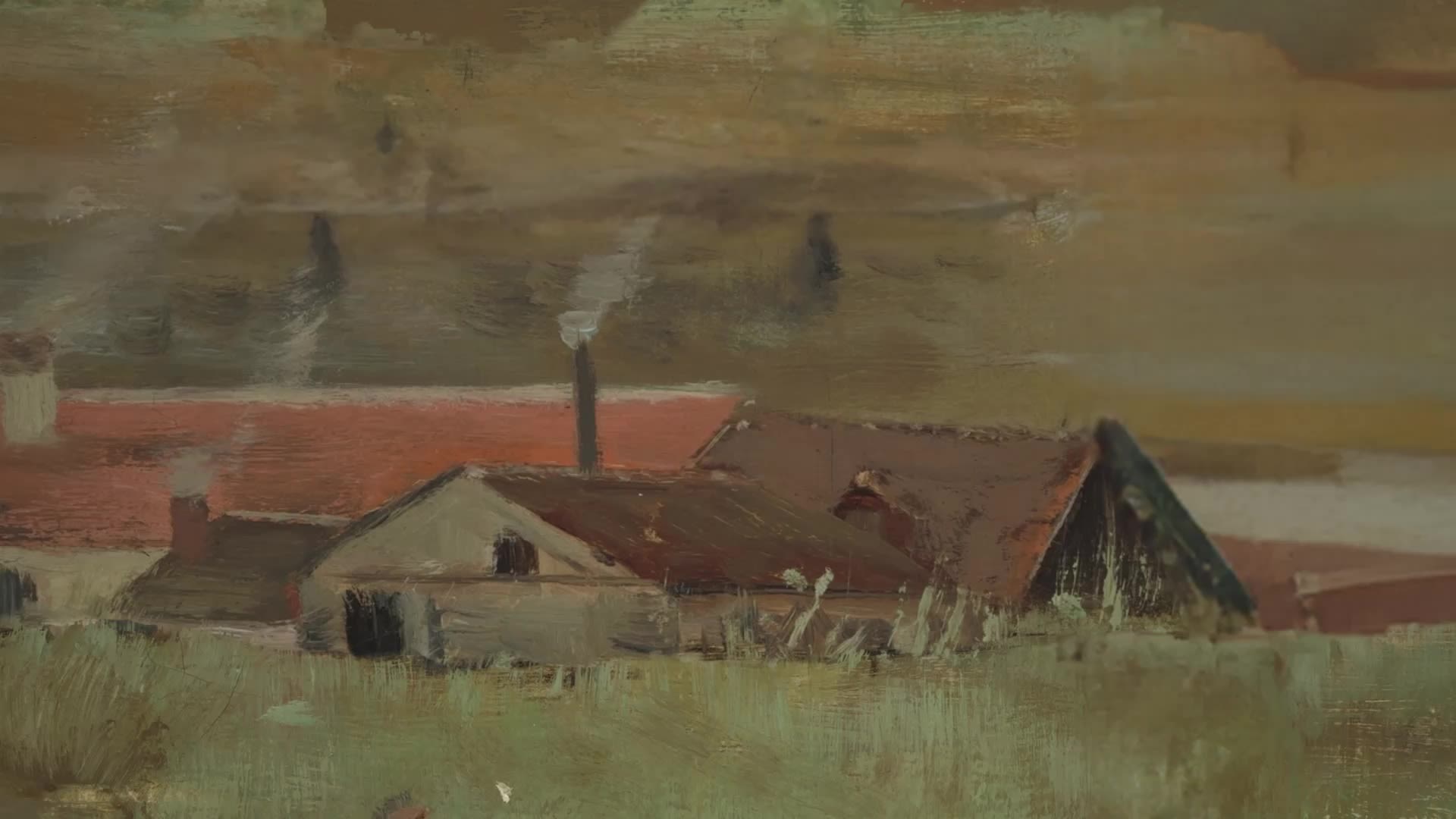
“
The true traveler never arrives.
—Edgar Degas

Purdue Galleries is thrilled to make the university the first institution in the world to showcase all 74 of Degas’s sculptures.
“Displaying the entirety of bronzes produced from Degas’s working models helps us as scholars better understand the wide range of subjects that fascinated him,” says Kirstin Gotway, the Luce Curator in the Rueff School of Design, Art, and Performance. “He was a meticulous artist, wanting to produce work that was grounded in reality. We hope that visitors will find new and surprising facets of Degas’s oeuvre when they visit the collection.”
Valued at more than $21 million and with a market value of as much as $52 million, the Degas Collection represents the largest gift in the history of Purdue’s College of Liberal Arts.
“This gift is transformational—it takes everything we do to an entirely new level,” says Erika Kvam, director and head curator at Purdue Galleries. “Av is the world’s loveliest man. There’s a huge level of trust when giving a gift like this. He felt Purdue is the place this collection will do the most good.”
Purdue has about 7,000 art objects in its collection, from ancient Peruvian textiles to 21st century photography. Gotway was brought in to research the extensive collection and make it more accessible to both students and researchers.
“The university has been actively collecting art since the day it opened,” she says. “The vast majority of our collection comes from generous donors like Av. We mostly have works on paper—drawings, photographs, and prints. This world-class gallery of bronzes allows us to highlight art on campus in a new way.”
Gotway says the collection tells the entire story of Degas and his process. “We’ve lined up all his sculptures, putting the same poses next to each other to show how he’s shifting the balance, how he’s finishing it, and how he’s playing with the space.”
The collection underscores the significance of Degas’s sculptural experiments in refining his vision and technique.
“His way of working mirrors the way our STEM students prototype and build new products in their fields,” says David A. Reingold, the senior vice president for policy planning and the Justin S. Morrill Dean of the College of Liberal Arts. “By exposing all Purdue students to these works and another way of seeing the world, we can catalyze their growth as creative and innovative thinkers and problem solvers.”
“I assure you no art was ever less spontaneous than mine. What I do is the result of reflection and study of the great masters; of inspiration, spontaneity, temperament—temperament is the word—I know nothing.”—Edgar Degas

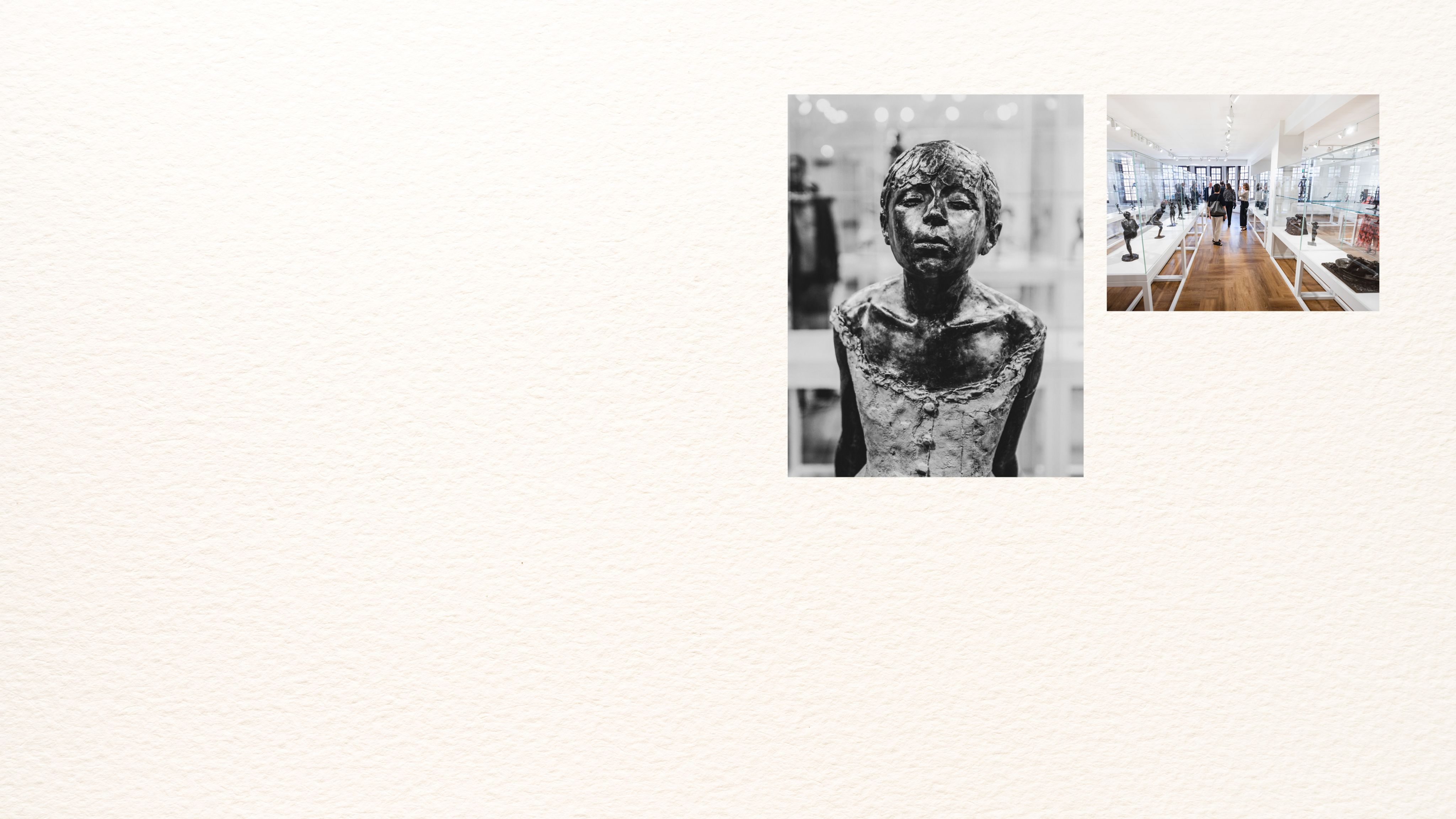
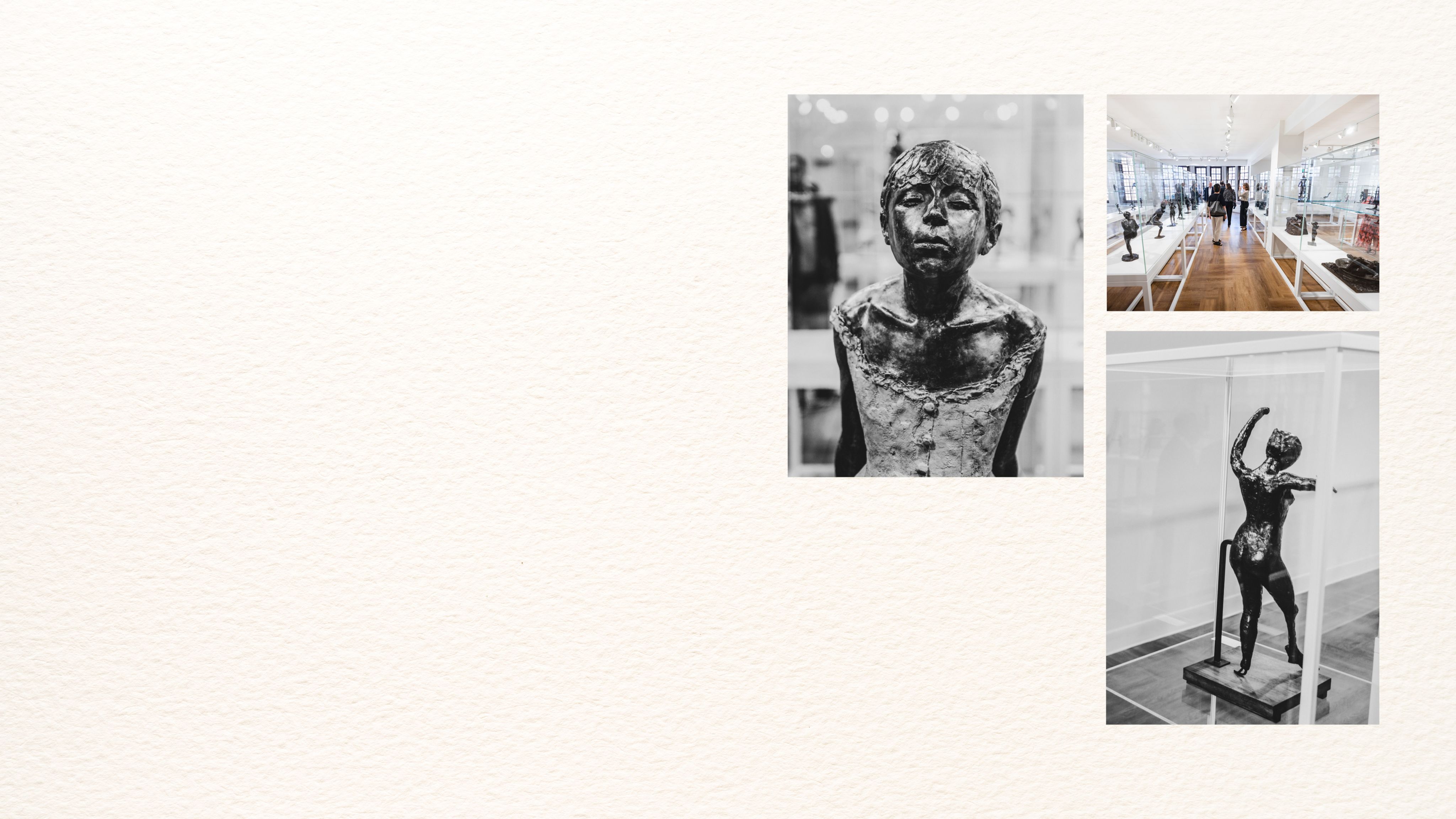
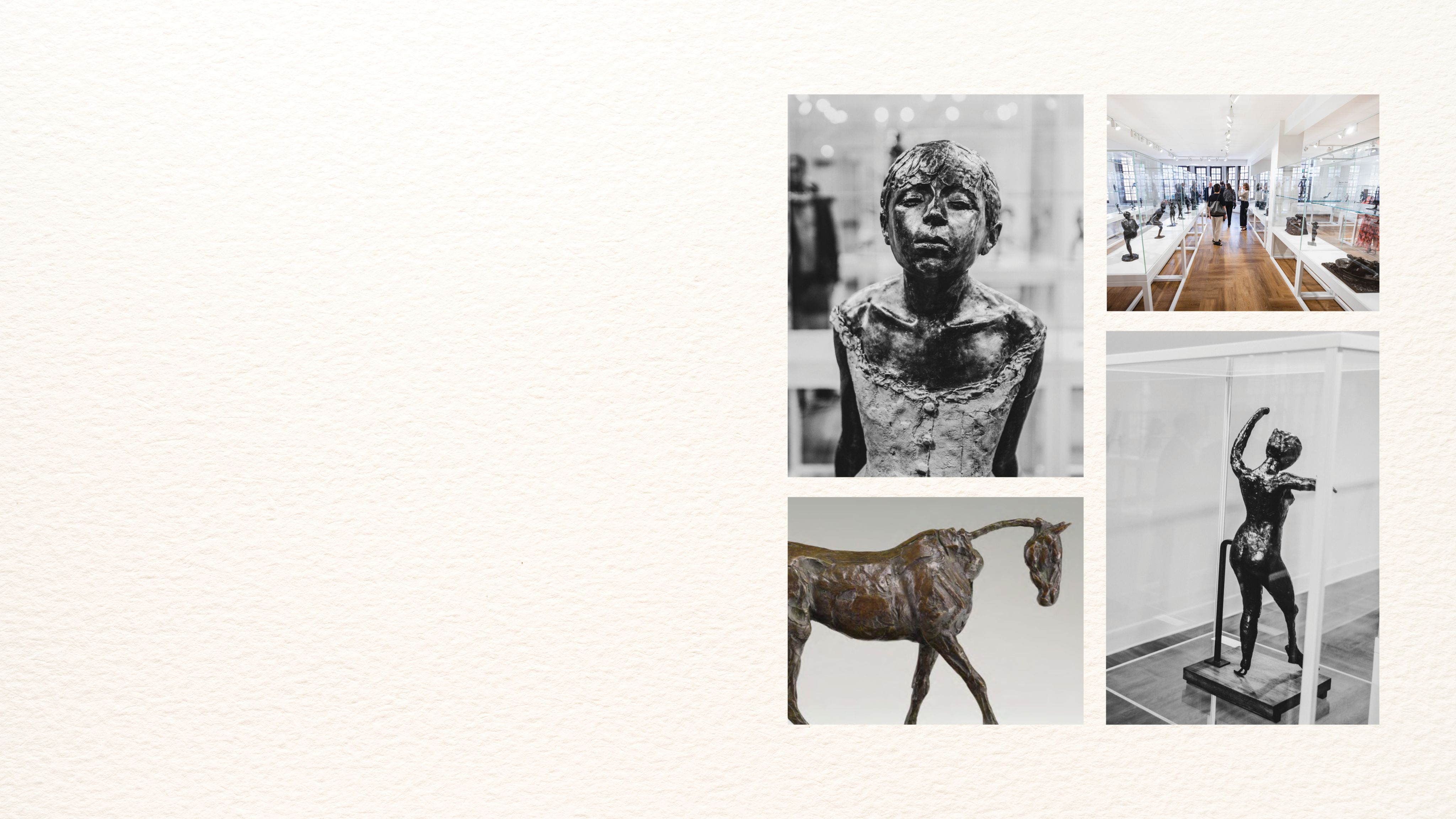
Purdue Galleries is thrilled to make the university the first institution in the world to showcase all 74 of Degas’s sculptures.
“Displaying the entirety of bronzes produced from Degas’s working models helps us as scholars better understand the wide range of subjects that fascinated him,” says Kirstin Gotway, the Luce Curator in the Rueff School of Design, Art, and Performance. “He was a meticulous artist, wanting to produce work that was grounded in reality. We hope that visitors will find new and surprising facets of Degas’s oeuvre when they visit the collection.”
Valued at more than $21 million and with a market value of as much as $52 million, the Degas Collection represents the largest gift in the history of Purdue’s College of Liberal Arts.
“This gift is transformational—it takes everything we do to an entirely new level,” says Erika Kvam, director and head curator at Purdue Galleries. “Av is the world’s loveliest man. There’s a huge level of trust when giving a gift like this. He felt Purdue is the place this collection will do the most good.”
Purdue has about 7,000 art objects in its collection, from ancient Peruvian textiles to 21st century photography. Gotway was brought in to research the extensive collection and make it more accessible to both students and researchers.
“The university has been actively collecting art since the day it opened,” she says. “The vast majority of our collection comes from generous donors like Av. We mostly have works on paper—drawings, photographs, and prints. This world-class gallery of bronzes allows us to highlight art on campus in a new way.”
Gotway says the collection tells the entire story of Degas and his process. “We’ve lined up all his sculptures, putting the same poses next to each other to show how he’s shifting the balance, how he’s finishing it, and how he’s playing with the space.”
The collection underscores the significance of Degas’s sculptural experiments in refining his vision and technique.
“His way of working mirrors the way our STEM students prototype and build new products in their fields,” says David A. Reingold, the senior vice president for policy planning and the Justin S. Morrill Dean of the College of Liberal Arts. “By exposing all Purdue students to these works and another way of seeing the world, we can catalyze their growth as creative and innovative thinkers and problem solvers.”
“I assure you no art was ever less spontaneous than mine. What I do is the result of reflection and study of the great masters; of inspiration, spontaneity, temperament—temperament is the word—I know nothing.”—Edgar Degas

The Degas Collection at Purdue University, located on the second floor of the Purdue Memorial Union, was opened to the public in September. The collection will be showcased at this location for 18 months.
Where the collection will go after that is still being determined; Purdue is the only university in the Big Ten without a museum.
For 20 years, David Parrish, a professor in the College of Liberal Arts, has been teaching Purdue students how museums operate through a course he designed called Art Museum Practices. He also serves as a curator for exhibitions at the university.
“Museums don’t just have an educational purpose, they have a great social and cultural impact on society as a whole,” he says. “Purdue has a very extensive collection of artwork scattered around campus, and the pieces need a permanent home. We’re hoping that one day we will have one.”
In the meantime, the newest addition to Purdue Galleries will inspire students and visitors, give them an additional perspective of life and art, and demonstrate how creativity drives innovation.
“We are grateful to everyone involved in bringing Degas’s sculptures to Purdue,” Gotway says. “We hope the collection will shift conversations around art at the university.”
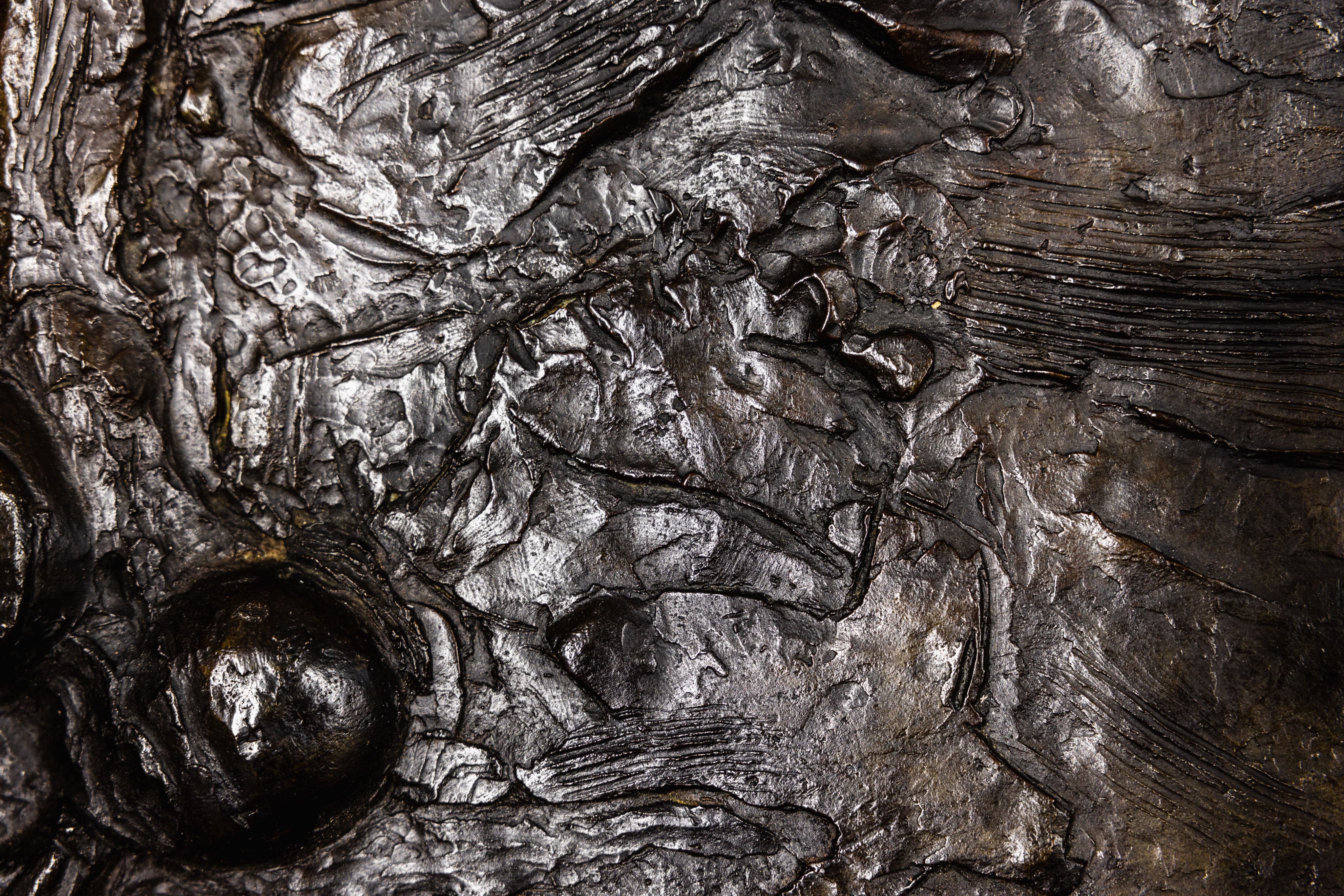
The Degas Collection at Purdue University, located on the second floor of the Purdue Memorial Union, was opened to the public in September. The collection will be showcased at this location for 18 months.
Where the collection will go after that is still being determined; Purdue is the only university in the Big Ten without a museum.
For 20 years, David Parrish, a professor in the College of Liberal Arts, has been teaching Purdue students how museums operate through a course he designed called Art Museum Practices. He also serves as a curator for exhibitions at the university.
“Museums don’t just have an educational purpose, they have a great social and cultural impact on society as a whole,” he says. “Purdue has a very extensive collection of artwork scattered around campus, and the pieces need a permanent home. We’re hoping that one day we will have one.”
In the meantime, the newest addition to Purdue Galleries will inspire students and visitors, give them an additional perspective of life and art, and demonstrate how creativity drives innovation.
“We are grateful to everyone involved in bringing Degas’s sculptures to Purdue,” Gotway says. “We hope the collection will shift conversations around art at the university.”

“
One sees what one
wants to see. It is false,
and that falsity
is the foundation of art.
—Edgar Degas
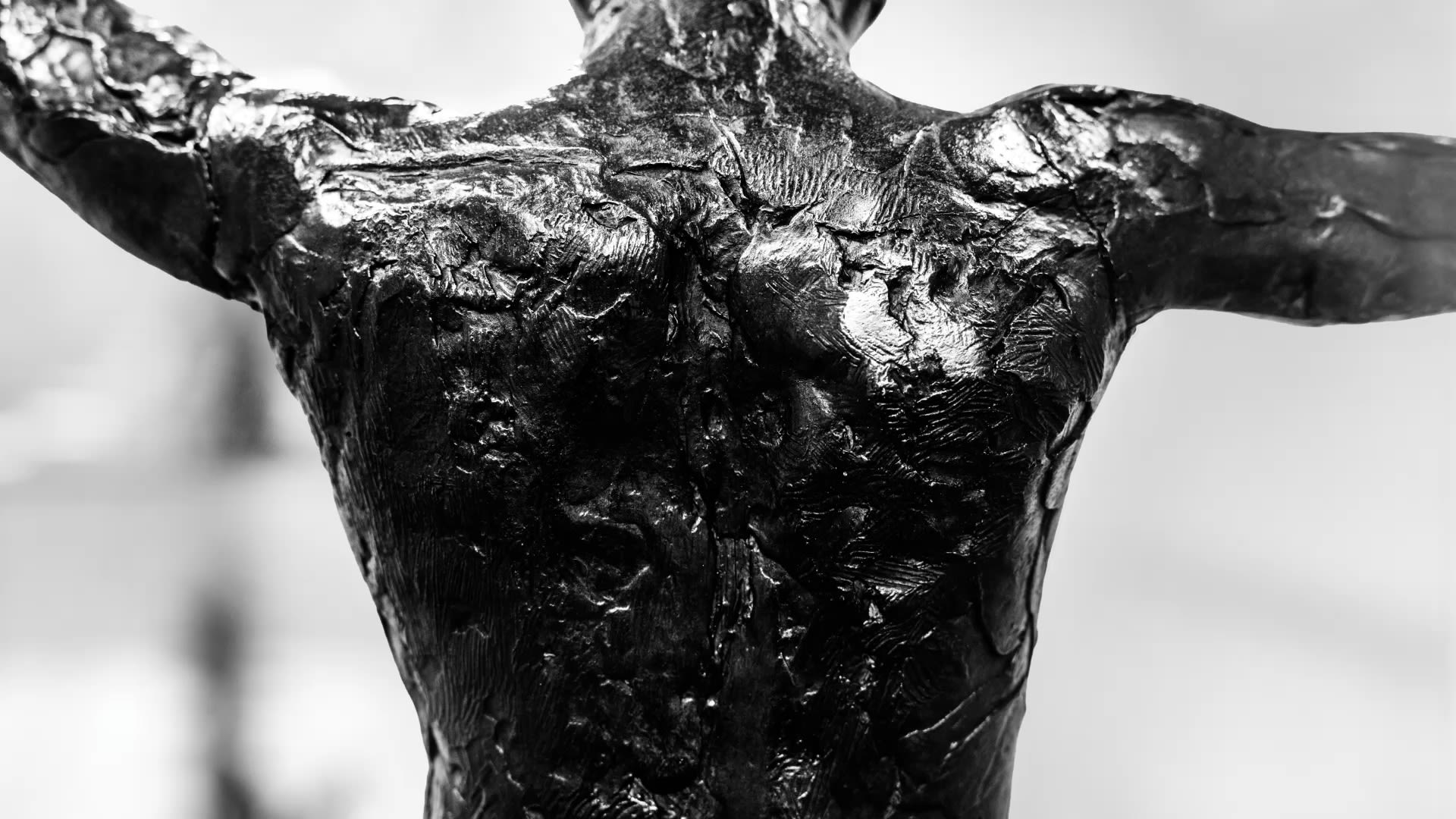
“
One sees what one wants to see. It is false, and that falsity is the foundation of art.
—Edgar Degas
—Edgar Degas







